
The Mid-Atlantic Ridge (MAR) is a mid-ocean ridge, a divergent or constructive plate boundary located along the floor of the Atlantic Ocean, and part of the longest mountain range in the world. In the North Atlantic, it separates the North American from the Eurasian Plate and the African Plate, north and south of the Azores Triple Junction respectively. In the South Atlantic, it separates the African and South American plates. The ridge extends from a junction with the Gakkel Ridge northeast of Greenland southward to the Bouvet Triple Junction in the South Atlantic. Although the Mid-Atlantic Ridge is mostly an underwater feature, portions of it have enough elevation to extend above sea level, for example in Iceland. The ridge has an average spreading rate of about 2.5 centimetres (1 in) per year.

Conoidea is a superfamily of predatory sea snails, marine gastropod mollusks within the suborder Hypsogastropoda. This superfamily is a very large group of marine mollusks, estimated at about 340 recent valid genera and subgenera, and considered by one authority to contain 4,000 named living species.

The Southwest Indian Ridge (SWIR) is a mid-ocean ridge located along the floors of the south-west Indian Ocean and south-east Atlantic Ocean. A divergent tectonic plate boundary separating the Somali Plate to the north from the Antarctic Plate to the south, the SWIR is characterised by ultra-slow spreading rates combined with a fast lengthening of its axis between the two flanking triple junctions, Rodrigues in the Indian Ocean and Bouvet in the Atlantic Ocean.

The Bouvet Triple Junction is a geologic triple junction of three tectonic plates located on the seafloor of the South Atlantic Ocean. It is named after Bouvet Island, which lies 275 kilometers to the east. The three plates which meet here are the South American Plate, the African Plate, and the Antarctic Plate. The Bouvet Triple Junction is an R-R-R type, that is, the three plate boundaries which meet here are mid-ocean ridges: the Mid-Atlantic Ridge (MAR), the Southwest Indian Ridge (SWIR), and the South American-Antarctic Ridge (SAAR).
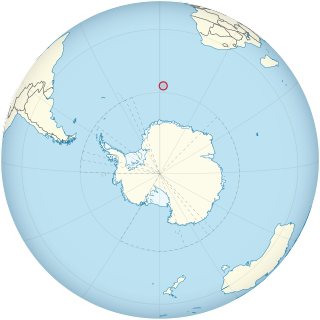
Bouvet Island is an uninhabited subantarctic volcanic island located in the South Atlantic Ocean at 54°25′S3°22′E. Politically, it is a dependency of Norway and, because it lies north of the region covered by the Antarctic Treaty System, it is not part of that system. Geographically, it is situated at the southern end of the Mid-Atlantic Ridge and is the most remote island in the world, lying as it does 1,700 kilometres (1,100 mi) north of the Princess Astrid Coast of Queen Maud Land, Antarctica, 1,900 kilometres (1,200 mi) east of the South Sandwich Islands, 1,600 kilometres (990 mi) south of Gough Island, and 2,600 kilometres (1,600 mi) south-southwest of the coast of South Africa.
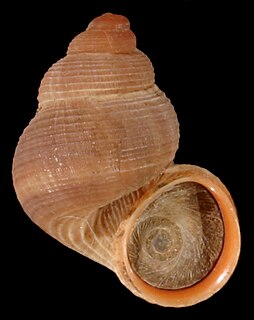
The family Pomatiidae is a taxonomic family of small operculate land snails, terrestrial gastropod mollusks that can be found over the warmer parts of the Old World. In the older literature, this family is designated as Pomatiasidae.
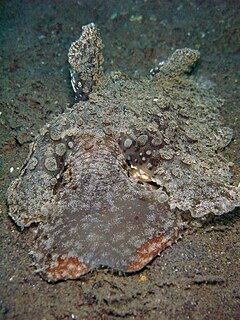
Melibe viridis is a species of sea slug, a nudibranch, a marine gastropod mollusk in the family Tethydidae.

Laevistrombus canarium is a species of edible sea snail, a marine gastropod mollusc in the family Strombidae. Known from illustrations in books dating from the late 17th century, L. canarium is an Indo-Pacific species occurring from India and Sri Lanka to Melanesia, Australia and southern Japan. The shell of adult individuals is coloured from light yellowish-brown to golden to grey. It has a characteristic inflated body whorl, a flared, thick outer lip, and a shallow stromboid notch. The shell is valued as an ornament, and because it is heavy and compact, it is also often used as a sinker for fishing nets.

Pachychilidae, common name pachychilids, is a taxonomic family of freshwater snails, gastropod molluscs in the clade Sorbeoconcha.
Tantulum elegans is a species of freshwater slug, an aquatic shell-less gastropod mollusk within the clade Acochlidiacea.

Freshwater snails are gastropod mollusks which live in fresh water. There are many different families. They are found throughout the world in various habitats, ranging from ephemeral pools to the largest lakes, and from small seeps and springs to major rivers. The great majority of freshwater gastropods have a shell, with very few exceptions. Some groups of snails that live in freshwater respire using gills, whereas other groups need to reach the surface to breathe air. In addition, some are amphibious and have both gills and a lung. Most feed on algae, but many are detritivores and some are filter feeders.
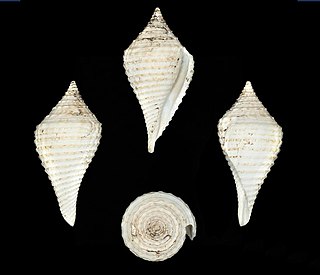
Conasprella armiger is a species of sea snail, a marine gastropod mollusk in the family Conidae, the cone snails and their allies.
Conorbis is an extinct genus of sea snails, marine gastropod mollusks in the family Conorbidae.

Notoficula bouveti is a species of sea snail, a marine gastropod mollusk in the family Buccinidae, the true whelks.

Parborlasia corrugatus is a proboscis worm in the family Cerebratulidae. This species of proboscis or ribbon worm can grow to 2 metres in length, and lives in marine environments down to 3,590 metres (11,780 ft). This scavenger and predator is widely distributed in cold southern oceans.

Californiconus is a genus of sea snails, marine gastropod mollusks. The experts at WoRMS place this group of species in the family Conidae, the cone snails, but some other experts placed previously the genus in a proposed family, the Conilithidae. This is a monotypic genus.
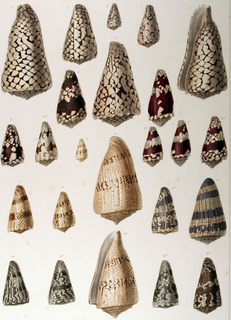
The taxonomy of the cone snails and their allies as proposed by John K. Tucker and Manuel J. Tenorio in 2009 was a biological classification system for a large group of predatory sea snails. This system was an attempt to make taxonomic sense of the large and diverse group which contains the family Conidae, the cone snails. The authors proposed extensive changes to the family Conidae in contrast to the way the group was treated in the taxonomy of the Gastropoda by Bouchet & Rocroi, 2005. Bouchet and Rocroi included in the family Conidae several other groups of toxoglossan snails which had previously been placed in the Turridae.

Conilithidae is a proposed taxonomic family of small to medium-sized sea snails, specifically cone snails, marine gastropod mollusks in the superfamily Conoidea, the cone snails and their allies.
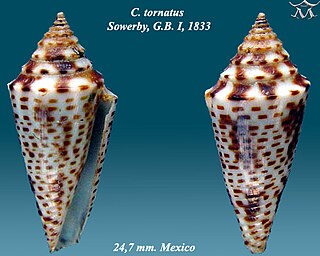
Globiconus is a subgenus of sea snails, marine gastropod mollusks in the genus Conasprella, family Conidae, the cone snails and their allies.

Lilliconus is subgenus of sea snails, marine gastropod mollusks in the genus Conasprella, family Conidae, the cone snails and their allies.

















